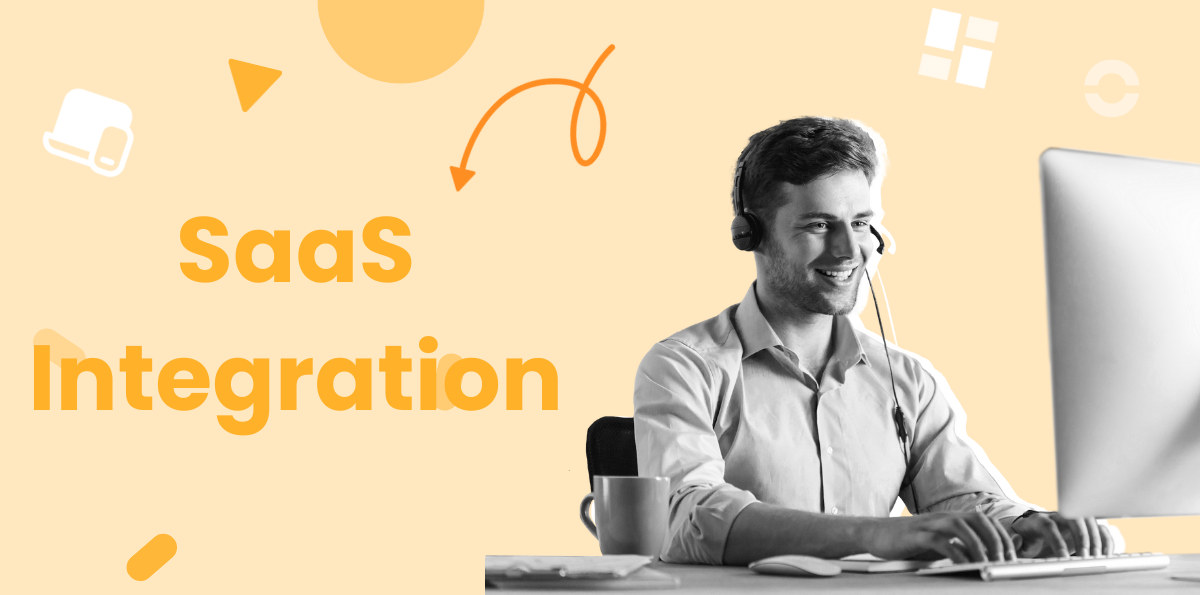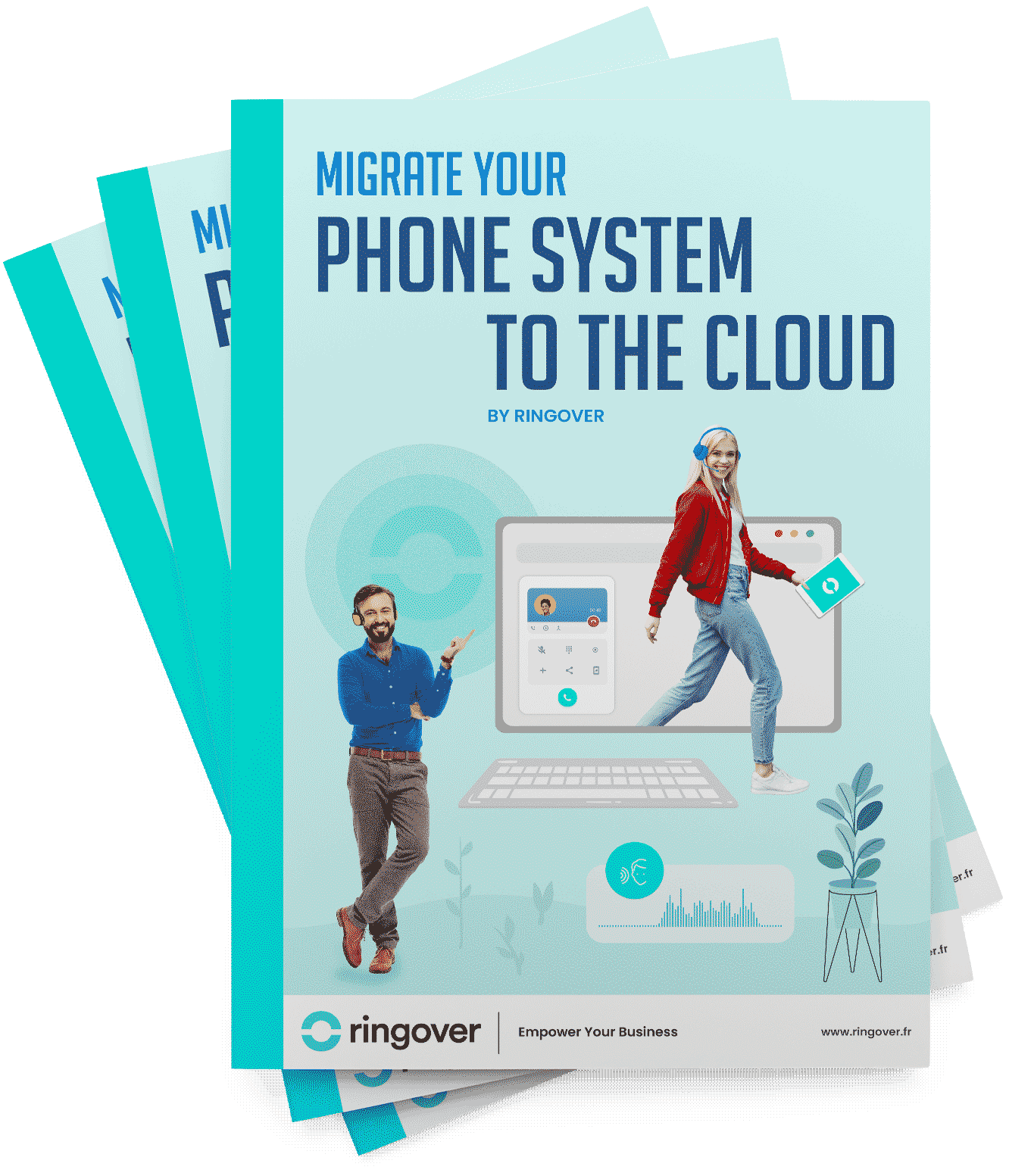Summary
SaaS integration plays a critical role in addressing this issue by acting as a key connector among these diverse software, facilitating seamless communication and data sharing. In this article, we'll dive into the realm of SaaS integration, examining its definition, advantages, examples, operational mechanisms, the various integration types available, and potential obstacles you may face.
Discover Ringover's SaaS IntegrationsWhat are SaaS Integrations?
SaaS integrations refer to the methods and technologies used for linking and synchronizing data across different Software as a Service (SaaS) platforms. These integrations facilitate uninterrupted communication and data sharing among various SaaS platforms, maintaining data consistency and currency throughout all systems.
Essentially, a SaaS integration establishes a connection between two or more SaaS applications to automate workflows, synchronize data, and boost overall business operations efficiency. This can be accomplished through several integration patterns, each tailored to meet particular requirements and contexts.
What Are the Benefits of SaaS Integrations?
SaaS integrations bring a wealth of advantages that can greatly boost the efficiency, productivity, and overall performance of your business. Here are the primary benefits of integrating your SaaS applications:
Saves Time and Reduces Manual Effort
Automating data transfer between applications through SaaS integration saves significant time. Without integration, manually transferring data between software applications is not only tedious but also prone to errors. Integrations automate these processes, allowing your team to concentrate on strategic tasks.
Reduces or Eliminates Human Error
Manual data entry often leads to errors, causing delays, customer dissatisfaction, and extra costs for corrections. SaaS integrations remove the need for manual data entry, ensuring accurate and consistent data transfer between software, thus reducing the chances of errors and maintaining data integrity.
Improves Data Quality and Consistency
By synchronizing data across multiple systems, SaaS integration eliminates data silos and ensures all software have access to the same, accurate, and up-to-date information. This enhances data quality and consistency, vital for informed business decisions. Integrated systems offer a unified source of truth, boosting data reliability and accuracy.
Enhances Visibility and Collaboration
Integrated SaaS applications offer real-time visibility into business processes and data, enabling teams to access necessary information timely, thus improving decision-making and collaboration. Seamless data sharing across departments fosters a more cohesive and efficient work environment.
Makes Processes Scalable
Manual processes can become cumbersome and inefficient as businesses grow. SaaS integrations allow your applications to scale with your business, managing increased data volumes and workflows automatically, which is essential for large enterprises with numerous applications across various departments.
Streamlines Reporting and Analytics
Integrated SaaS applications enable comprehensive reporting, offering insights into various operational aspects of your business. This facilitates performance monitoring, trend identification, and informed strategic decision-making, while also reducing the time and effort needed for report preparation.
Offers Improved Flexibility
SaaS integrations offer the flexibility to adapt to changing business needs with minimal upfront investment. You can add new functionalities or services as needed and integrate them with existing systems, which is essential for supporting remote work environments and mobile access.
Examples of a SaaS Integration
To showcase the practical application of SaaS integrations, let's delve into some real-world examples that highlight how integrating different SaaS applications can significantly improve business operations.
Ringover and Salesforce Integration
A prime example of effective SaaS integration is the synergy between Ringover, a cloud-based business phone system, and Salesforce, a premier CRM software. This integration empowers sales teams to effortlessly manage their calls, contacts, and customer interactions directly within the Salesforce interface.
Through this integration, calls made via Ringover are automatically logged in Salesforce, guaranteeing that every customer interaction is meticulously recorded and easily accessible. Moreover, sales representatives can directly dial contacts from within Salesforce, enhancing their workflow and minimizing the time dedicated to manual data entry.
Ringover and Bullhorn Integration
Another noteworthy integration is between Ringover and Bullhorn, a leading recruitment software. This integration offers substantial benefits for recruitment agencies that depend on effective communication for candidate relationship management and manage client interactions.
With this integration, recruiters can initiate calls directly from the Bullhorn platform, with call logs and recordings automatically synchronized to the candidate's profile. This centralization of communication history simplifies tracking interactions and following up with candidates and clients, thereby enhancing the recruitment process's overall efficiency by automating routine tasks and providing real-time updates.
Salesforce and Mailchimp Integration

A popular integration example is between Salesforce and Mailchimp. This integration facilitates the synchronization of contact data and campaign analytics between the two platforms, streamlining marketing efforts.
For example, when a new contact is added in Salesforce, it can be automatically included in a Mailchimp mailing list, ensuring that marketing campaigns are consistently aligned with the most current customer information. Additionally, this integration allows for the monitoring of email campaign performance within Salesforce, offering a comprehensive overview of customer interactions and the effectiveness of marketing campaigns. This seamless data exchange is instrumental in personalizing marketing strategies and enhancing customer engagement.
Slack and Google Calendar Integration

The integration between Slack and Google Calendar exemplifies how connecting SaaS applications can boost productivity. This integration enables employees to receive instant notifications about upcoming meetings and schedule changes directly within Slack.
Users can configure Slack to alert them when a meeting is imminent or when their Google Calendar schedule changes, ensuring team members are well-informed and punctual, thus reducing missed meetings and fostering better team coordination.
Google Workspace and Trello Integration

The integration of Google Workspace and Trello showcases the powerful combination of productivity tools to enhance collaboration and task management. This integration allows teams to integrate task management with real-time collaboration, enabling the creation and assignment of tasks directly from Google Workspace applications like Gmail or Google Drive.
For instance, emails in Gmail can be transformed into Trello cards, and files from Google Drive can be attached to these cards. This integration simplifies project management by centralizing all pertinent information and tasks, thereby promoting enhanced collaboration and productivity among team members.
How Does SaaS Integration Work?
SaaS integration involves a series of steps and technologies that enable different SaaS applications to communicate and share data seamlessly. Here's a detailed look at how this process works:
Using APIs and Predefined Rules
SaaS integration primarily relies on Application Programming Interfaces (APIs) to facilitate data exchange between applications. APIs act as intermediaries, allowing different systems to communicate by using established rules and protocols.
These APIs authenticate the applications, establish trust, and authorize data transfer in standard formats such as XML and JSON.
Trigger Mechanisms and Data Exchange
SaaS integrations often utilize trigger mechanisms that activate when specific actions are performed within an application. For example, when a new customer signs up on your platform, a trigger can send this data to your CRM system, ensuring that the customer's information is updated in real-time or through batch processing.
Integration Models
There are several integration models that can be employed, each with its own advantages and complexities:
- Point-to-Point Integration: This model involves direct connections between multiple endpoints or nodes. It is straightforward but can become complex as the number of connections increases.
- Hub-and-Spoke Integration: This model uses a central hub that connects to several spokes or nodes. It simplifies the integration process by centralizing the connections, making it easier to manage and maintain.
- Hybrid Integration: This approach combines different integration models to accommodate various scenarios. It offers flexibility and can handle complex integration requirements by leveraging the strengths of multiple models.
Integration Platforms and Tools
To simplify the integration process, businesses often use Integration Platform as a Service (iPaaS) solutions. These platforms provide prebuilt pathways between different SaaS applications, offering no-code integration capabilities that save time and reduce the need for extensive programming.
Additionally, tools like Robotic Process Automation (RPA) can be used to automate data collection and synchronization between SaaS applications and internal systems. RPA employs AI-powered bots to enhance efficiency, although it may require ongoing maintenance and can be affected by UI changes.
Data Transformation and Mapping
During the integration process, data often needs to be transformed to ensure compatibility between different systems. Integration middleware uses transformers to convert data from one format to another, ensuring that the data is presented in a machine-readable format on the remote side.
Testing and Validation
Before deploying SaaS integrations, thorough testing is essential to ensure data precision, functionality, and performance. This involves verifying the integration workflows across various scenarios, engaging stakeholders and end-users for feedback, and detecting issues proactively to mitigate potential disruptions.
Security and Compliance
SaaS integration also involves ensuring data security and compliance. This includes adding multiple security protocols and encryptions, using industry-compliant integration platforms, and specifying roles and restrictions to control access to the data. Regular testing and validation help in maintaining the security and integrity of the integrated systems.
Ringover and Empower offer a wide variety of integrations, allowing you to easily build an efficient tech stack that supports your team in delivering their best performance.
What Kinds of SaaS Integrations Are There?
SaaS integrations can be categorized into several types, each serving different purposes and addressing various integration needs. Here are some of the primary kinds of SaaS integrations:
Integration Platform as a Service (iPaaS)
iPaaS is a cloud-based integration platform designed to connect SaaS applications, as well as on-premises systems. It provides a configurable and scalable solution for integrating multiple applications, allowing users to build automations without extensive coding. iPaaS platforms like Zapier, MuleSoft, and Talend are popular for their ease of use and the ability to handle complex integrations.
Embedded iPaaS (eIPaaS)
Embedded iPaaS solutions are integrated directly into the SaaS product itself, enabling customers to build and deploy their own integrations within the vendor's software. This approach allows SaaS companies to offer native integrations to their customers, simplifying the integration process and providing a seamless user experience. Examples of embedded iPaaS include Pandium, Tray Embedded, and Cyclr.
Unified APIs
Unified APIs create a layer of abstraction that allows engineering teams to interact with multiple SaaS APIs simultaneously through a single interface. This approach simplifies the integration process by enabling a single integration to support multiple APIs, reducing the complexity and effort required to build and maintain multiple individual integrations.
Unified APIs are particularly useful for SaaS companies that need to integrate with various third-party applications.
Custom Integrations
Custom integrations involve in-house developers building and maintaining integrations tailored to the specific needs of the business. This approach offers high flexibility and customization but can be complex, time-consuming, and expensive. Custom integrations are suitable for businesses with unique requirements that cannot be met by standard integration solutions.
Middleware Integration
Middleware integration involves using intermediary software to connect SaaS applications and on-premises systems. This can include traditional enterprise service bus (ESB) tools and modern iPaaS platforms. Middleware solutions help in managing the flow of data between different systems, ensuring compatibility and efficient data exchange.
Robotic Process Automation (RPA) Integrations
RPA integrations use software bots to automate repetitive tasks such as data extraction, manual data entry, and other routine activities across multiple SaaS applications. RPA is particularly useful for integrating legacy systems with modern SaaS applications, reducing the risk of human error and freeing up employees for more strategic activities.
Customer-Facing Integrations
Customer-facing integrations are designed to enable end-users to integrate their own applications with the vendor's platform. These integrations are often facilitated through embedded iPaaS or unified APIs, allowing customers to build and deploy their own automations without requiring extensive technical expertise.

SaaS Integration Challenges
Despite the numerous benefits of SaaS integrations, several challenges can arise during the implementation and maintenance process. Understanding these challenges is essential for developing effective strategies to overcome them and ensure seamless integration.
Data Difficulties
Data silos and inconsistent data occur when SaaS applications, developed by different teams using varying technology stacks and standards, store data separately. This fragmentation can lead to significant challenges such as compatibility issues, data loss, workflow disruptions, or the need for extensive custom development to ensure interoperability. Ensuring flawless integration across these diverse systems can be difficult, often resulting in data inaccuracies, decision-making inefficiencies, or outdated information due to real-time data access issues.
Security Safety
Security concerns are paramount when integrating SaaS applications. It's critical to ensure proper authentication and authorization mechanisms to prevent unauthorized access, data leaks, or manipulation by malicious actors. Inadequate or improperly configured security measures can expose APIs to cyberattacks, compromising the integrity of the integrated system.
Scaling the Business
Scalability issues can emerge, especially when integrations are managed in-house. As the number of integrations grows, so does the demand for resources such as developer time and support infrastructure, leading to significant investments that may not directly correlate with the benefits of the integrations. These challenges can also stem from SaaS vendors' limitations, such as restrictions on API calls and data access.
Adequate Support
SaaS vendors often have varying levels of integration support, API capabilities, and data access limitations. These differences can lead to vendor lock-in, making it difficult to switch to different vendors in the future and affecting the stability and continuity of integrated systems due to different release cycles and update schedules.
Developing and maintaining custom API integrations can be complex and time-consuming, requiring specialized knowledge and often involving multiple development and testing iterations. Despite best efforts, software bugs and manual workarounds can minimize the return on investment.
Inconsistent Performance
Performance issues, such as latency or reliability problems in data transfer between SaaS APIs and your system, can affect user experience and the overall efficiency of the integrated workflows. Robust monitoring tools and processes are essential for real-time data synchronization and minimizing downtime.
Sufficient Documentation
Accessing comprehensive and up-to-date API documentation poses significant challenges. Developers may need to form partnerships with vendors for access, search across multiple web pages, or deal with documentation that is outdated or not available for the current API version, delaying the integration process.
Encouraging Adoption
Ensuring user adoption of new integrated systems can be challenging, with resistance potentially leading to low adoption rates. This resistance can directly impact the Return on Investment (ROI) of the SaaS company, as the benefits of integration are not fully realized if users do not adopt the new system.
Concluding Thoughts
In conclusion, SaaS integration plays a pivotal role in the functionality of contemporary businesses, offering a myriad of advantages such as significant time savings, minimized human errors, enhanced data transparency, and improved experiences for both customers and employees.
To understand the difference a great integration can make, start your free Ringover trial. Once you've got your cloud phone system up and running (which can be done in a matter of minutes!) start configuring integrations and discover the possibilities!
SaaS Integration FAQ
What is an example of SaaS?
An example of SaaS is Salesforce, a cloud-based Customer Relationship Management (CRM) platform. Salesforce enables businesses to manage all their customer data, leads, and sales processes through a web-based interface, eliminating the need to install or maintain software on their own servers.
Other examples include Google Workspace, Dropbox, and Netflix, which offer services like productivity tools, cloud storage, and video streaming, respectively.
What does SaaS stand for?
SaaS stands for Software as a Service. It's a software delivery model in which applications are hosted by a third-party vendor and provided to customers over the internet, either on a subscription or pay-as-you-use basis. This approach frees customers from managing the underlying infrastructure, focusing instead on utilizing the software.
What is SaaS and API?
SaaS (Software as a Service) and API (Application Programming Interface) are closely related yet distinct concepts. SaaS is the delivery model for providing software applications over the internet by a third-party vendor. APIs are the sets of rules and protocols enabling different software systems to communicate.
In the realm of SaaS, APIs commonly facilitate the integration of SaaS applications with other systems, allowing for data exchange and workflow automation. For instance, a SaaS application like Salesforce might leverage APIs to connect with other business tools, such as email marketing software or project management platforms.




